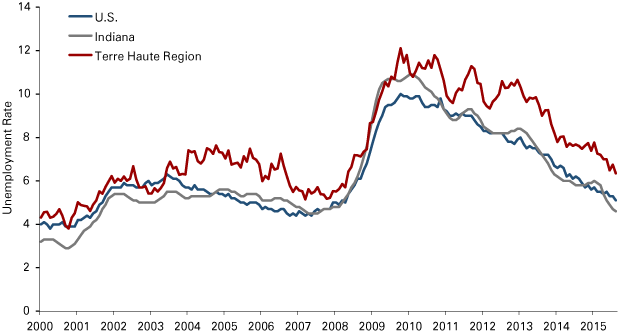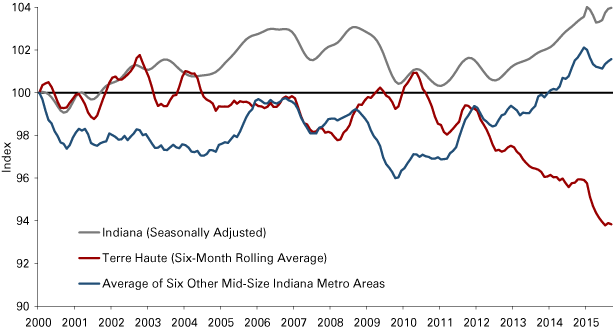Terre Haute Forecast 2016
Professor of Economics, Indiana State University
Associate Professor of Economics, Rose-Hulman Institute of Technology
The Terre Haute region—along with the national and state economies—continues to emerge slowly from the shadow of the Great Recession of 2008 and 2009, although it faces some obstacles in terms of long-term secular trends and new headwinds as 2015 turns to 2016. Given the historic relationship between regional employment trends and national and state-level economic activity, the regional economy also faces significant risks going forward.
The national “recovery,” such as it is, is now in its seventh year (from a declared start in the summer of 2009), already more than a year longer than the average expansion of 11 postwar recoveries. If the legs of the national recovery begin to tire, we know from historical experience that the Terre Haute regional economy will have trouble keeping pace. Given its present condition, it would seem that the regional economy is in a precarious situation and desperately needs new and bold leadership, good luck, or some combination of both.
Labor Market Trends
On a seasonally adjusted basis, the Terre Haute region’s unemployment rate fell 1.4 percentage points during the first nine months of 2015, mirroring a similar fall in the rate at the state level (see Figure 1). As with state and national reductions in unemployment, however, there is some question as to whether the fall in the rate is due to increasing employment or to people leaving the labor force. The Terre Haute labor force actually fell by about 1,000 between late summer 2014 and late summer 2015.
Figure 1: Seasonally Adjusted Unemployment Rates, January 2000 to September 2015

Source: Authors’ calculation, using U.S. Bureau of Labor Statistics data
This drop in the local labor force is, we believe, part of a troubling secular trend. Since 2000, the Terre Haute region’s labor force has fallen by about 7 percent, with 5.5 percent of that fall occurring since 2010, during which time it fell from 81,000 to about 76,500 (see Figure 2). During this period, the area’s population also fell, but not by as much—only about 0.5 percent. This seems to indicate that labor force participation rates in the area are rapidly declining. Until recently, the same could be said of the national and state economies, but as Figure 2 shows, the state labor force and those in other mid-size Indiana metro areas have actually been growing at a brisk pace since 2012.
Figure 2: State and Local Labor Force Index

Note: The six other mid-sized Indiana metro areas used for this comparison are Bloomington, Columbus, Elkhart-Goshen, Kokomo, Lafayette-West Lafayette and Muncie.
Source: U.S. Bureau of Labor Statistics
Behind the statistics lie stories about unfulfilled hopes of new sources of employment. Indeed, it is difficult to find instances of significant new sources of employment for the area in its recent history. Most of the employment gains have been of a relatively insignificant variety—nothing in the way of “game-changing” announcements of new jobs coming to the area. Where there have been promises of significant and meaningful new jobs, such as the NantWorks venture and the ill-fated Powerdyne sludge-to-diesel proposal, those promises have largely remained unfulfilled.
Okun’s Law as a Forecasting Tool
Okun’s law, which expresses an empirical relationship between changes in output growth and unemployment, represents the simplest of macroeconomic forecasting models, and may signal troubling clouds on the region’s economic horizon. For the Terre Haute region, historically, this relationship has meant that area unemployment only falls when national GDP grows by at least 2.2 percent. Consensus forecasts for 2016 GDP growth have recently been undergoing downward revisions, and currently center at about 2.4 percent. If those forecasts are correct, and all other things remain unchanged, this implies that the Terre Haute region’s unemployment rate will probably not change significantly from its current level of 5.8 percent (6.5 percent on a seasonally adjusted basis).
Of course, all other things are rarely unchanged. It is possible that the unemployment rate could continue to fall slowly because the regional labor market is shrinking, as has been the case for the past few years. Obviously, this would not be a sign of regional economic vitality. This leaves the region’s economy in a tenuous position, waiting for another shoe to drop.
The fact is that one major plant closure or a slight downturn in the national economy would probably have significant negative effects on the region’s economy. One only needs to look at the history of Terre Haute’s former largest employer, the shuttered Columbia House, or the closure of the Pfizer facility, to imagine the consequences should one of the city’s largest current employers, Sony, see the physical media business (Blu-Ray and game discs) contract significantly—a scenario that seems increasingly likely.
The Confidence Factor
In our view, another potential headwind facing the local economy has emerged in the form of questions about local fiscal management. While every city and county in Indiana faced challenges when property tax caps were instituted by constitutional amendment, some engaged those challenges head on and made difficult decisions about services and new sources of revenue. The city of Terre Haute did not. From just prior to those caps until late 2015, the city has transitioned from an operational fund balance that was in the black by more than 25 percent of the annual budget to one that is now more than 25 percent in the red.
The city’s fiscal travails have been well-documented in the local press, and this is coverage that cannot be hidden from prospective employers who may be looking at the Terre Haute area for relocation or expansion. As a recent editorial in the Terre Haute Tribune-Star noted, these difficulties are hard to ignore:
“The city of Terre Haute is suffering through a tense and confusing period in its history. It has severe financial problems, brought on primarily by the state’s property tax caps, but clearly made worse by an inability or unwillingness on the part of elected officials to take it seriously and deal with it effectively.”1
As any financially desperate entity would do when trying to avoid uncomfortable action, the city engaged in what some may characterize as reality-denying actions. It systemically began slow-paying contractor and vendor bills. At one point, it bought time by paying its trash-collecting contractor with a credit card, and at another time borrowed money from the dewatering company associated with the ill-fated Powerdyne deal. In yet another non-traditional approach to civic financial management, the city seemed to use a contrived dispute with the county over 911 service to delay paying its share for that service.
We believe that the uncertainties surrounding city financial management reflect poorly on the area, undermine confidence in local economic leadership, and may constitute an avoidable headwind for economic development. It is difficult, we think, to envision scenarios where major employers would consider locating in Terre Haute when such clouds of fiscal mismanagement hang over the area’s dominant municipality.
Forecast
On a positive note, major construction projects at Indiana State University (ISU) and on the nearly completed 641 bypass on Terre Haute’s southeast corner have provided some economic stimulus and will both continue into 2017. Nevertheless, unless ISU enrollment continues to increase at its present (perhaps unsustainable) rate, and unless there is bold leadership to sell the benefits of the bypass to the logistics industry, neither of these positives will be enough to bring significant new growth to the community as a whole.
In summary, we think it unlikely that there will be any significant change in the Terre Haute labor market in 2016. The outlook for the Terre Haute regional economy remains about what it has been for the past few years: Barring bold new thinking, the most likely scenario seems to be for continued stagnation.




